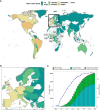A comprehensive review of monkeypox virus and mpox characteristics
- PMID: 38510963
- PMCID: PMC10952103
- DOI: 10.3389/fcimb.2024.1360586
A comprehensive review of monkeypox virus and mpox characteristics
Abstract
Monkeypox virus (MPXV) is the etiological agent of monkeypox (mpox), a zoonotic disease. MPXV is endemic in the forested regions of West and Central Africa, but the virus has recently spread globally, causing outbreaks in multiple non-endemic countries. In this paper, we review the characteristics of the virus, including its ecology, genomics, infection biology, and evolution. We estimate by phylogenomic molecular clock that the B.1 lineage responsible for the 2022 mpox outbreaks has been in circulation since 2016. We interrogate the host-virus interactions that modulate the virus infection biology, signal transduction, pathogenesis, and host immune responses. We highlight the changing pathophysiology and epidemiology of MPXV and summarize recent advances in the prevention and treatment of mpox. In addition, this review identifies knowledge gaps with respect to the virus and the disease, suggests future research directions to address the knowledge gaps, and proposes a One Health approach as an effective strategy to prevent current and future epidemics of mpox.
Keywords: antivirals; biosafety; epidemiology; evolution; genomics; infection biology; monkeypox; one health.
Copyright © 2024 Alakunle, Kolawole, Diaz-Cánova, Alele, Adegboye, Moens and Okeke.
Conflict of interest statement
The authors declare that the research was conducted in the absence of any commercial or financial relationships that could be construed as a potential conflict of interest.
Figures





Similar articles
-
Monkeypox virus emerges from the shadow of its more infamous cousin: family biology matters.Emerg Microbes Infect. 2022 Dec;11(1):1768-1777. doi: 10.1080/22221751.2022.2095309. Emerg Microbes Infect. 2022. PMID: 35751396 Free PMC article. Review.
-
Intra- and interhost genomic diversity of monkeypox virus.J Med Virol. 2023 Aug;95(8):e29029. doi: 10.1002/jmv.29029. J Med Virol. 2023. PMID: 37565686 Free PMC article.
-
Concurrent Clade I and Clade II Monkeypox Virus Circulation, Cameroon, 1979-2022.Emerg Infect Dis. 2024 Mar;30(3):432-443. doi: 10.3201/eid3003.230861. Epub 2024 Feb 7. Emerg Infect Dis. 2024. PMID: 38325363 Free PMC article. Review.
-
Monkeypox Outbreak 2022, from a Rare Disease to Global Health Emergence: Implications for Travellers.Adv Exp Med Biol. 2024;1451:355-368. doi: 10.1007/978-3-031-57165-7_23. Adv Exp Med Biol. 2024. PMID: 38801590 Review.
-
Human monkeypox virus: Epidemiologic review and research progress in diagnosis and treatment.J Clin Virol. 2024 Apr;171:105662. doi: 10.1016/j.jcv.2024.105662. Epub 2024 Feb 28. J Clin Virol. 2024. PMID: 38432097 Review.
Cited by
-
From pox to protection: understanding Monkeypox pathophysiology and immune resilience.Trop Med Health. 2025 Feb 26;53(1):33. doi: 10.1186/s41182-025-00708-6. Trop Med Health. 2025. PMID: 40011970 Free PMC article. Review.
-
Portable molecular diagnostic platform for rapid point-of-care detection of mpox and other diseases.Nat Commun. 2025 Mar 24;16(1):2875. doi: 10.1038/s41467-025-57647-3. Nat Commun. 2025. PMID: 40128193 Free PMC article.
-
Monkeypox virus spreads from cell-to-cell and leads to neuronal death in human neural organoids.Nat Commun. 2025 Jun 30;16(1):5376. doi: 10.1038/s41467-025-61134-0. Nat Commun. 2025. PMID: 40588500 Free PMC article.
-
Mpox: Global epidemic situation and countermeasures.Virulence. 2025 Dec;16(1):2457958. doi: 10.1080/21505594.2025.2457958. Epub 2025 Feb 8. Virulence. 2025. PMID: 39921615 Free PMC article. Review.
-
Challenges and opportunities in the face of Mpox in Latin America.Ther Adv Infect Dis. 2024 Oct 23;11:20499361241292627. doi: 10.1177/20499361241292627. eCollection 2024 Jan-Dec. Ther Adv Infect Dis. 2024. PMID: 39493725 Free PMC article. No abstract available.
References
-
- Aden T.A., Blevins P., York S.W., Rager S., Balachandran D., Huston C.L., et al. (2022). Rapid diagnostic testing for response to the monkeypox outbreak — Laboratory response network, United States, may 17–june 30, 2022. MMWR Morb. Mortal Wkly. Rep. 71, 904–907. doi: 10.15585/mmwr.mm7128e1 - DOI - PMC - PubMed
Publication types
MeSH terms
LinkOut - more resources
Full Text Sources
Medical

